Menu
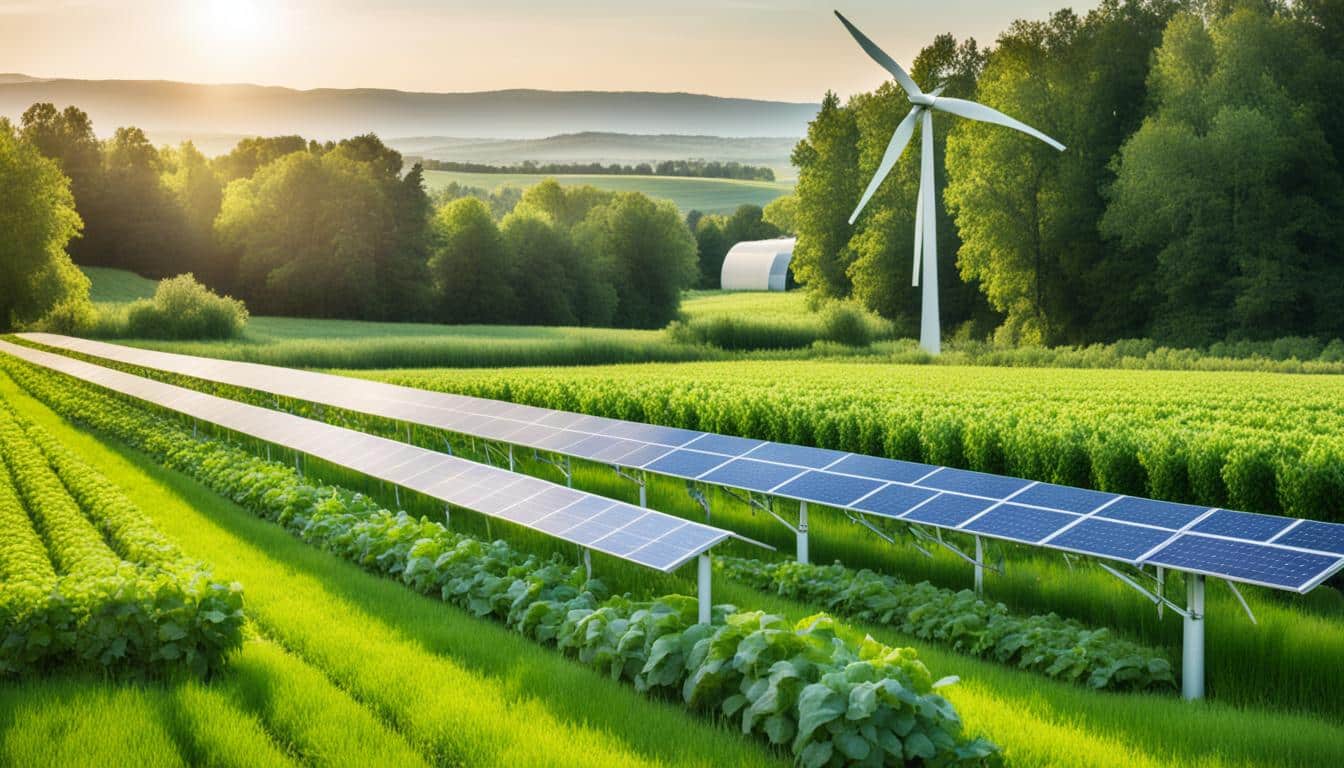
Did you know the EQIP helps farmers with both money and technical support? It helps them deal with important natural resource issues. This shows how helping farmers change to eco-friendly ways can make a big difference. It’s not only good for them, but for keeping our food supply safe and our planet healthy.
A study of 18,000 papers highlighted changes needed in farming. Things like crop rotation, cover crops, and using fewer pesticides are big steps. These methods help the land use resources better, keep soil healthy, and cope with climate change. Governments and groups working with the public are key. They offer money and rewards for following eco-friendly rules. Also, they give advice and learning to make these changes easier for farmers.
Financial incentives can encourage farmers to use eco-friendly methods. They balance the benefits for the economy with those for the environment. Incentives range from renewable energy subsidies to carbon offset incentives. They aim to push farmers towards green farming practices.
The Environmental Quality Incentives Program (EQIP) is a key scheme. It provides farmers with both money and advice on adopting eco-farming. Farmers get help with water and air quality, saving water, soil health, and protecting wildlife.
Through EQIP, up to 75% of conservation costs can be covered. Some groups, like new farmers and veterans, can get even more help. There are projects for high tunnels, organic farms, air quality, and energy saving. A broad approach to conservation is clear.
These schemes go beyond just money. They cut down on farm pollution and help the land use nutrients better. They aim for better soil and to fight climate change. This helps the land cope with hard times like droughts.
Don’t forget, the Natural Resources Conservation Service (NRCS) gives free expert advice. This helps farmers pick the best ways to protect their land. This free help makes sure farmers keep using eco-friendly methods for the long haul.
Incentives like renewable energy subsidies and carbon offset incentives really help. They encourage farmers to care for the environment without losing out on money. These methods support the UN’s goals for a greener world. They offer a win-win for the planet and farming.
Environmental quality is essential for everyone and is influenced by what we all do. Since 1970, the EPA has worked hard to enforce environmental rules. These rules help to reduce pollution’s harm when the polluters don’t pay the full cost. This makes strong environmental policies very important.
Global agreements tackle issues like climate change and protecting wildlife. Following these agreements leads to rewards and encourages responsibility. Laws such as the National Environmental Policy Act in the U.S. invite people to help make choices. This shows that taking care of the environment is a group effort.
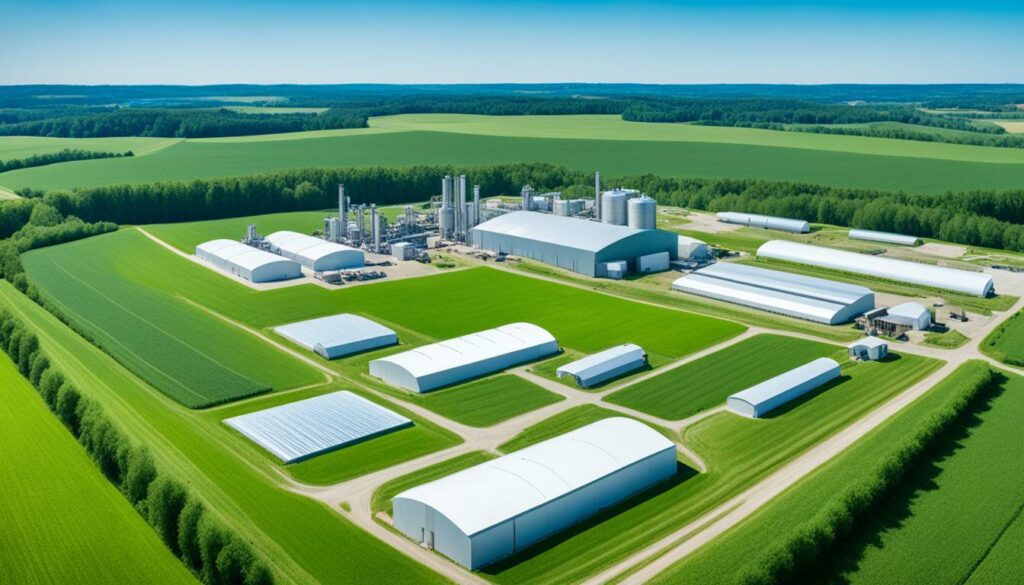
The EPA looks after laws like the Clean Air Act and the Clean Water Act. These rules have made the air and water cleaner, especially in badly polluted areas. For companies, following these laws can make their work better and show the worth of saving resources.
Air pollution control saves lives and stops sick days for millions. Ways like tradable permits make it cheaper for companies to follow the rules. Studies have looked at how these rules affect the economy, especially in making products cleaner.
| Regulation | Impact | Compliance Incentives |
|---|---|---|
| Clean Air Act | Improved Air Quality | Pollution Control Incentives |
| Clean Water Act | Enhanced Water Quality | Environmental Compliance Rewards |
| Climate Agreements | Combat Climate Change | Climate Action Funding |
To end, following environmental laws is not just about what’s legal. It’s a duty we have to our health and nature. Combining these laws with rewards can help us build a better world for all.
Financial incentives are important for making farmers choose eco-friendly actions. They include market-based, non-market, regulatory, and cross-compliance types. Each type has its own way of working and purpose.
Market-based incentives use money to push farmers towards greener choices. Things like subsidies, carbon pricing, and tradable permits are examples. These methods pay farmers for using renewable energy or cutting pollution.
In some places, farmers can sell extra solar power back to the grid. And, there are federal subsidies to support making and using biofuels too.
Non-market incentives don’t need buyers or sellers. They provide help directly. For example, the EQIP in the U.S. offers money and advice to farmers. This helps farmers tackle barriers and take up green practices.
Regulations join green goals with financial rewards. Emission trading is one such setup. It lets farmers trade pollution permits. This keeps pollution low but also pays those who pollute less.
Cross-compliance incentives tie money to meeting eco rules. Farmers must follow green laws to get paid. This makes sure money goes to those doing good for the earth.
Together, these incentives create a strong system for farming that’s good for the planet. Through different methods, they guide farmers towards actions that support nature. This mix is key to making eco-friendly farming common.
The government and policymakers are key in promoting green farming. They do this by offering rewards for caring for the land. They use tools and support to make sure that what farmers do helps the Earth.
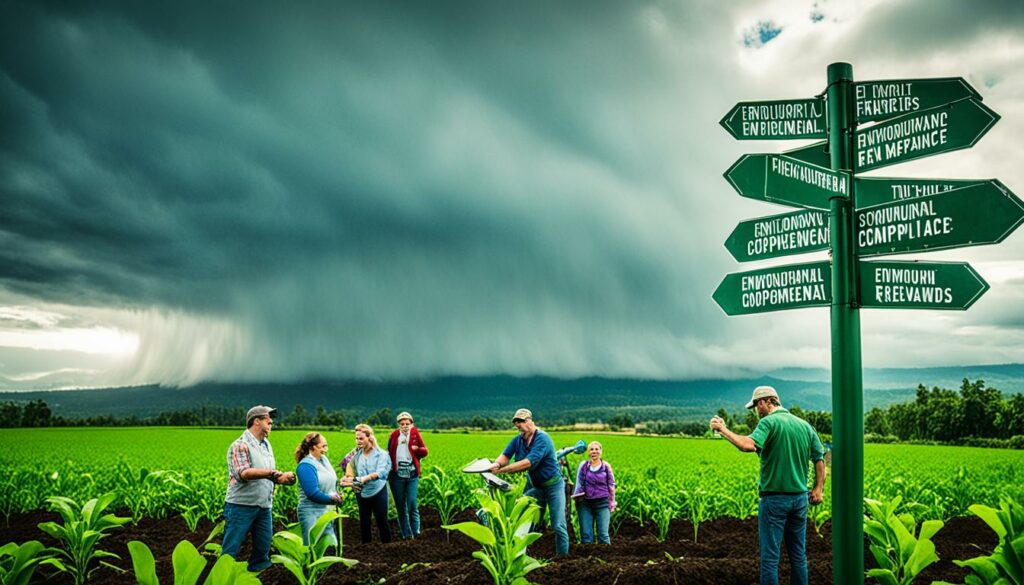
Governments help farmers through giving money and support. The EQIP helps pay for smart farming methods. The CSP gives long contracts for looking after the land well. The conservation program also makes sure certain lands are used in the right way.
Policymakers have come up with many rules to make farming better for the planet. They have laws on using land right and protecting water. They also use money and labels to encourage good farming. This all helps make farming kinder to the Earth.
These rules show that good farming can benefit everyone. They make sure we have clean water and protect our land. They also help farmers earn money by being green. This support really makes a difference.
| Programme | Type of Support | Key Impact |
|---|---|---|
| EQIP | Financial Assistance | Adoption of Best Management Practices |
| CSP | Long-term Contracts | Implementation of Conservation Practices |
| Agricultural Conservation Easement Program | Voluntary Easements | Protection of Wetlands |
| Environmental Credit Trading | Pollution Reduction Credits | Compliance with Pollution Control Laws |
Financial incentives are key in making the world greener. Governments use sustainable development grants to push companies to be more eco-friendly. These incentives motivate great practices in farming and protect the environment.
Financial rewards help a lot in improving soil and water. For example, the EQIP scheme guides farmers to use methods that make their soil better. This increases what they grow and keeps the water clean by reducing problems like erosion.
It’s been found that just 100 companies are causing a lot of greenhouse gas emissions. Therefore, it’s very important to get them to follow eco-friendly ways.
Financial perks are also making a big difference in lessening pollution. By offering pollution control incentives, more companies are joining the fight against bad emissions and waste. Since June 2022, a 40 percent increase has been seen in the number of companies aiming for net zero emissions.
Also, half of the world’s biggest listed companies aim for zero emissions by 2050. This shows how important financial help is in reaching these green goals.
Renewable energy subsidies are pushing us closer to a green economy. By making it easier for people and businesses to choose clean energy, the subsidies are reducing our need for fossil fuels. Supporting clean energy creates jobs and encourages new, green ideas.
People now care a lot more about the environment. A recent study found that 70 percent of people would pay a bit more for a product if it helped the planet and worked just as well. This shift in thinking is creating a big demand for green items, which can also be helped by things like tax breaks and eco-friendly incentives.
It’s very important for governments and the market to work together for a greener future. They need to keep checking and changing the financial support they offer, to keep up with how things are changing.
| Statistics | Data |
|---|---|
| Companies Responsible for Greenhouse Gas Emissions | 100 companies are responsible for 70% |
| Rise in Net Zero Emissions Targets Since June 2022 | 40% |
| Top Global Companies with Net Zero Emission Targets by 2050 | 50% |
| Consumer Willingness to Pay More for Green Products | 70% |
Financial incentives linked to green rules can make farmers choose eco-friendly ways. In the United States, there’s a program called EQIP. It supports farmers with money and knowledge to use better farming methods. They tackle things like carbon pricing, paying for cleaner energy, helping with tech to cut pollution, and offering money back for using energy wisely.

Money incentives help farmers take care of the Earth better. Things like trading permits, labelling things as eco-friendly, and buying green all push farmers to meet high environmental goals. These help cut down on polluting gases and keep nature safe and sound.
Green rewards come in many shapes, including tax breaks and money back, help to control pollution, flexible permits, and rules on where to build. They’re great for getting farmers to work in Earth-friendly ways. Using these rewards can bring new ways of working, save money, and create new jobs.
But, making these rewards work well faces big problems. People worry they might not be fair, that they could help big business too much, and that they’re not checked up on closely enough. Making green rewards work needs strong plans, careful checking, and help from other countries.
Big companies need to do their bit too. They should share how they’re working on green efforts and stick to ways that help the Earth. Plus, they should keep thinking of new, kinder ways of doing business, to match the world’s green goals.
Key plans in eco-economics include the U.S. EPA’s Emission Trading Program and the push to stop using lead in petrol. These show how mixing financial perks with green guide lines helps a lot. They encourage looking after the planet and find smarter actions to lessen pollution.
Case studies show how well-made programmes can help nature and farming. The Conservation Reserve Program (CRP) and Environmental Quality Incentives Program (EQIP) are good examples.
They have done a lot to reward good environmental actions. This is how they work and what they have achieved:
The CRP is run by the Farm Service Agency. It pays farmers to plant friendly covers on lands that are at risk. This helps the soil, water, and gives more space to animals. It’s a great balance of helping nature and farmers.
The EQIP helps farmers with money and advice to be more eco-friendly. It is run by the Natural Resources Conservation Service. It focuses on water, soil, and making homes for wildlife. A European study found that programmes like EQIP help businesses do better while being green.
These programmes work well together to benefit everyone. They show that combining nature protection with funding for farming is a good idea. They also teach us to make incentives fit the place to be the most helpful.
It’s key to know why farmers join eco-friendly incentive programmes. They look at many things that affect their choice. These factors together decide if they’ll take part and how they’ll respond to such offers.
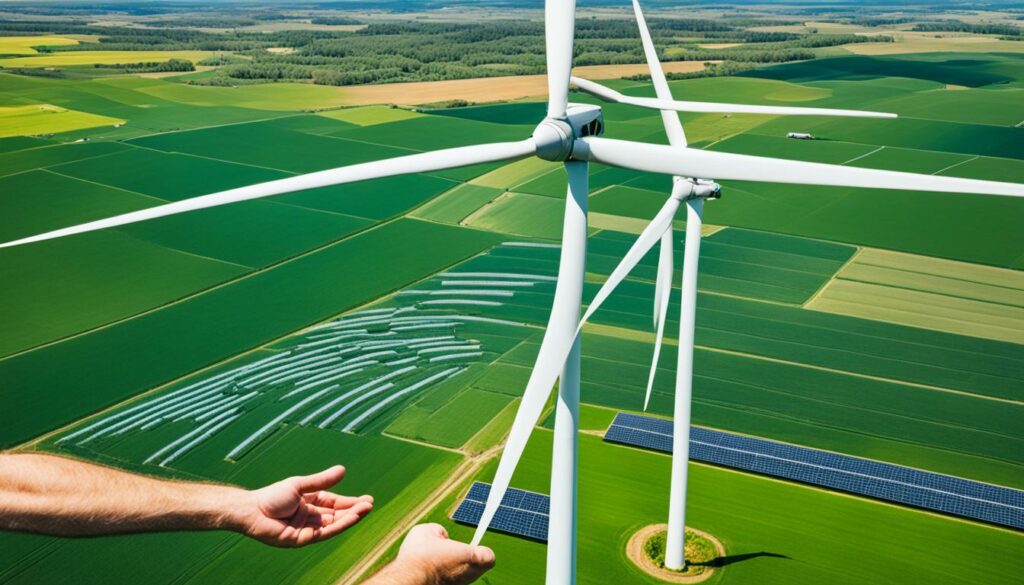
Money is a big reason for farmers to join in. For instance, a large fund like the USDA’s $5 million can make a difference. It supports projects that help the environment but also save money.
This is shown in a 2016 Land Economics study. It talks about how financial incentives can make water conservation more effective. So, any project helping the environment must also help the farm’s budget.
Farmers also think about long-term gains from eco-friendly incentive programmes. Better water and soil, for example, are big pluses. They lead to more sustainable farms with better profits.
They also see benefits like easier environmental rules and big studies supporting the cause. For example, China and New Zealand’s success stories push farmers towards taking part. They consider how these benefits can help their own farms.
So, joining these e programs means farmers must see clear benefits. Such as making money and helping the planet. If these are well explained, more farmers will take part for the long haul.
Using money to encourage eco-friendly actions faces many issues. The main problems are making the rules work and actually getting green results. We have to be very smart about how we measure success to keep things fair.
Getting everyone to use these financial perks right is also tricky. Take Hungary for example. They put €1.5 billion towards green efforts. But making sure this money helps all farmers fairly is tough. The same goes for Poland and its push for green power.
Another big challenge is making these financial boosts work for everyone. They must fit different places and cultures. This is hard. Hungary and Poland are doing well with EU help. But not all countries find green policies easy to adopt.
Watching and making sure people follow the rules is also a massive task. Strong checking is needed to run any scheme well. But this is a big challenge. If we don’t check properly, the best ideas can go wrong. This happens when groups don’t work well together or if people cheat.
“The lack of political will is a constant obstacle to the rapid deployment of effective climate and environmental action.”
Making smart money plans also means picking the right financial tools. There are many kinds. The US has good examples like pollution trading. But not every plan works perfectly. Bad designs and high hopes can lead to problems.
Some new groups’ beliefs are also making things harder for green plans. While left-leaning parties often support green steps, not everyone is on board. This political gap can slow down big green rewards.
Kata Barbara Moravecz is a great example. She came third in an eco essay contest. Her work proves that study can influence decisions. But still, convincing many people and groups to act is not easy. Many factors make it hard to agree on green actions.
| Country | Challenges | Examples of Policy Instruments |
|---|---|---|
| Hungary | Equitable distribution of green bonds | €1.5 billion commitment towards green bonds |
| Poland | Shift from coal to green energy | Investment in green energy driven by EU funds |
| United States | Monitoring and enforcement | EPA’s Emission Trading Program, RECLAIM programme |
For farmers, technical assistance and extension services are key when dealing with the challenges of financial incentives environmental regulations. Programs like the Conservation Stewardship Program and EQIP from USDA show the importance of these services. They support farmers with everything from planning to training, aiming to help them use best methods.

This extensive technical assistance helps farmers make the most of financial support. The EQIP, for instance, can pay for 75 percent of certain practices. For some farmers facing social disadvantages, this can go up to 90 percent. Such help is vital. It lets farmers adopt sustainable methods without the full cost being on them.
Extension services add more than just support; they offer education and advice too. They make sure farmers know and meet legal needs, like those from the Clean Water Act. This means farms meet environmental standards while following the law.
They also help farmers join in new programmes, such as environmental credit trading. This allows farmers to earn by reducing pollution. With the assistance, they aim to get involved in activities that cut down on harmful runoff.
To wrap up, technical assistance and extension services play a major part in turning financial incentives environmental regulations into practical farm ways. They offer the needed support for planning and doing, which helps more farmers use better, lasting methods. This improves the sustainability of farming overall.
Sustainable farming brings many lasting benefits. It helps farms to do better both now and in the future. By using these methods, farmers can make more food and meet goals for a better world.
Sustainable methods are key to making farms more productive. Actions like changing which crops are grown, planting more crops between main ones, and controlling pests in smart ways keep the land healthy. This stops soil from wearing away, uses water better, and helps farms keep going strong even when the weather or markets are tough. Studies show that farms that work this way grow more food and stay in good shape economically.
The good thing about sustainable farming isn’t just making money. It’s also about making our world better, which is what the United Nations wants. These ways of farming help fight poverty, make sure there’s enough safe food for everyone, fight climate change, and look after the life in our oceans and on land. Governments and rules push farmers to use these good methods by offering money and setting laws. Planting trees near crops, for example, can help more animals and plants live there, catch carbon, and keep the world in balance.
With more and more people in the world, we need to farm in ways that don’t harm the Earth. By giving money and making laws, we can make sure farming helps the planet. This means healthier soil, less need for harmful chemicals, and a stronger Earth overall.
Conserving biodiversity is vital for sustainable farming. With carefully planned biodiversity conservation schemes, we can help keep our planet healthy. The Convention on Biological Diversity supports these efforts worldwide. It has active since 1993, joined by over 130 nations. This help comes in the form of schemes like protecting natural areas, cost-sharing, and more.
The importance of biodiversity often gets overlooked by individuals and groups. This leads to harm in our environment. However, offering rewards can steer people and organisations to protect nature. Using money wisely can turn threats to biodiversity into opportunities for a better planet.

Ensuring wildlife has safe places to live is a key strategy. Shockingly, many species may vanish, especially in tropical areas. Approaches like enhancing species and setting rules guide landowners to do better. They help keep our natural spaces for the future.
Agroforestry, mixing farming with trees, is very important. It builds stronger farms and provides homes for different life forms. This mix makes farming systems more stable over time. Incentives that encourage agroforestry are attractive. They push farmers to adopt this approach, which benefits the environment.
Using smart incentives and working closely with different groups is key in biodiversity work. These measures help save natural homes and promote farming that lasts. This is how we can keep our planet thriving for the generations to come.
In farming, tackling pollution and fighting climate change are key. It’s important to use money to help reduce the harm from farming on the planet. This means encouraging ways to farm that cut down on bad gases and help store carbon. Programmes like the ones from the USDA and the EQIP are vital in helping farmers achieve these aims.
The Inflation Reduction Act creates big chances for getting money to fight climate change. For example, there’s $4.6 billion up for grabs in grants to cut down greenhouse gases. The NDEP’s $3 million grant for its Priority Climate Action Plan is proof that structured money can boost climate solutions. The CRP gives farmers the chance to keep their land from farming, which cuts emissions and helps capture carbon.
Carbon offset rewards are key in getting farmers to practice climate-friendly farming. The US EPA’s request for a big amount, $99 million, is aimed at cutting down carbon emissions big time by 2030. Conservation banking by the U.S. Fish and Wildlife Service helps balance the loss of valuable habitats by restoring them. This not only fights climate change but also helps protect wildlife’s homes.
Farmers can do more for the planet when they get help to do the right thing. These help include both checks to ensure they follow rules and money to use proven methods. By working together, we can make farming more sustainable. This will not only help our planet but also our economy.
Climate change is causing more floods, bush fires, and hurricanes. So, governments all over the world are working harder to push for sustainable development. This effort means there are more and more eco-friendly incentive programmes. These help us shift to a green economy.
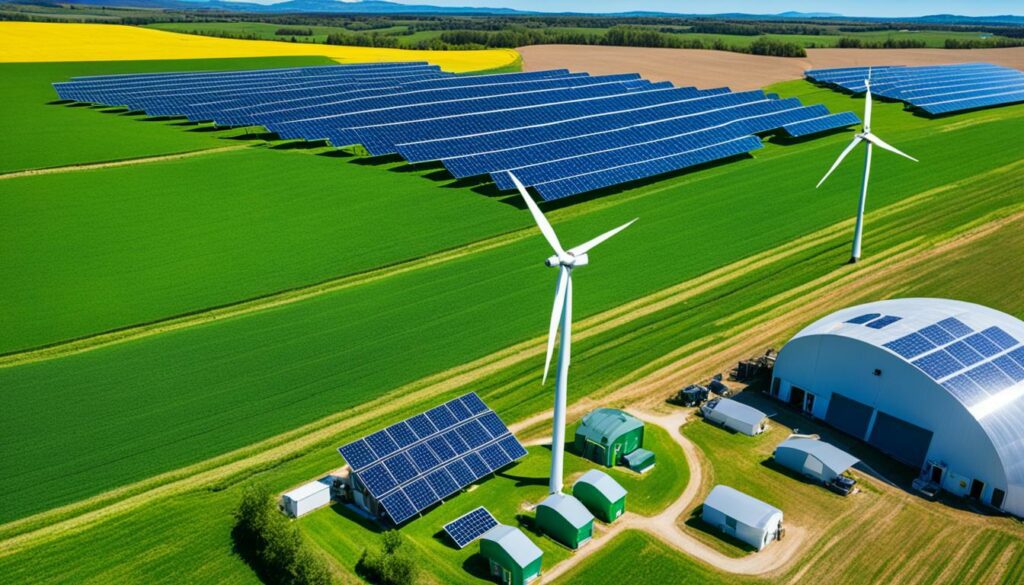
Programmes like tax breaks, grants, and subsidies are key in the green economy. They push businesses and people to use green practices. This cuts down on air pollution and helps save nature. They also make it easier to use renewable energy.
It might cost a bit more at first to use green energy technology. But in the long run, it saves money. Initiatives like the Business Energy Tax Credit and Electric Car Tax Credit give big savings. Grants and eco-friendly business support also help a lot.
Going green can save money on bills, earn from selling greenhouse gas credits, and lots of tax perks. It’s not just about money; it means new ideas, more work, and growing the economy. Government actions like the Green Jobs Initiative mean training and money for green research.
Other rules, like limits on how much pollution a company can make, also help. They give reasons for using cleaner tech. Plus, programs for protecting nature encourage careful land use and saving wildlife.
In short, eco-friendly incentives are crucial. They drive the economy in ways that use less and protect more. They help all kinds of businesses move towards being kinder to the earth.
The sections above have shown why we need to pay farmers. It helps keep our planet safe. Giving farmers money for eco-friendly work is key to our future. It makes sure they help the environment while earning a living.
Many research pieces say these payments work. One example is from the Energy Economics journal in 2022. They looked at how selling carbon credits improved how plants work.
Another example is from the Journal of Environmental Management in 2020. They found taxing polluters in China led to a better green economy. These findings prove that paying for good environmental practices helps.
About 40 places around the world pay farmers to be green. They want to cut pollution and save nature. For example, the EU will offer €10 billion by 2030 to help green projects.
Also, the US managed to lower a harmful gas with a special fund’s help. This shows that when we all work together, we can make a big difference.
In the end, paying farmers to go green is good for them and the planet. It helps control pollution and fights climate change. These efforts are vital for a sustainable future.
Financial incentives offer immediate money gains and long-term ecological wins. They make farmers follow eco-friendly farming methods. These include using resources better and harming nature less.
Incentives range from subsidies and technical help to setting standards for certain actions. There are also rules to follow regarding various activities. Different schemes cover everything from renewable energy to saving wildlife.
These rules stop harm to the environment, making sure the cost of damage is considered. Incentives encourage farmers to protect nature. This keeps our planet healthy and balanced.
They provide money, help, and good rules. This covers teaching, setting eco-standards, and making good farming deals. It encourages sustainable ways to farm.
The CRP and EQIP are good examples. They reward farmers for helping the environment. These show that helping farmers can also help our planet.
Economic gains and help for their farms and nature are important. They think about the benefits for the earth and society, too. This balance is key in choosing what to do.
Making good programmes to reward farming that protects nature is hard. It’s important these schemes are fair for all. Scaling up, checking, and making sure rules are followed are also challenges.
They help farmers bridge the gap between money rewards and putting them into practice. These services offer vital help with planning and applying. They make these incentives work well on the ground.
Sustainable farming brings both quick and lasting benefits. It helps the farm, the environment, and supports big global goals. It works towards less poverty, more food, and protecting nature.
These rewards help save wildlife homes and encourage more trees on farms. This makes a better home for plants and animals. The farming area becomes stronger and more varied.
They help cut harmful gases and keep carbon dioxide in check. This supports global efforts to fight climate change. They make sure farmers are doing their part to protect the planet.
These programmes spark new ideas and push for clean energy. They support the green economy’s aims. This helps farming become greener and better for our world.